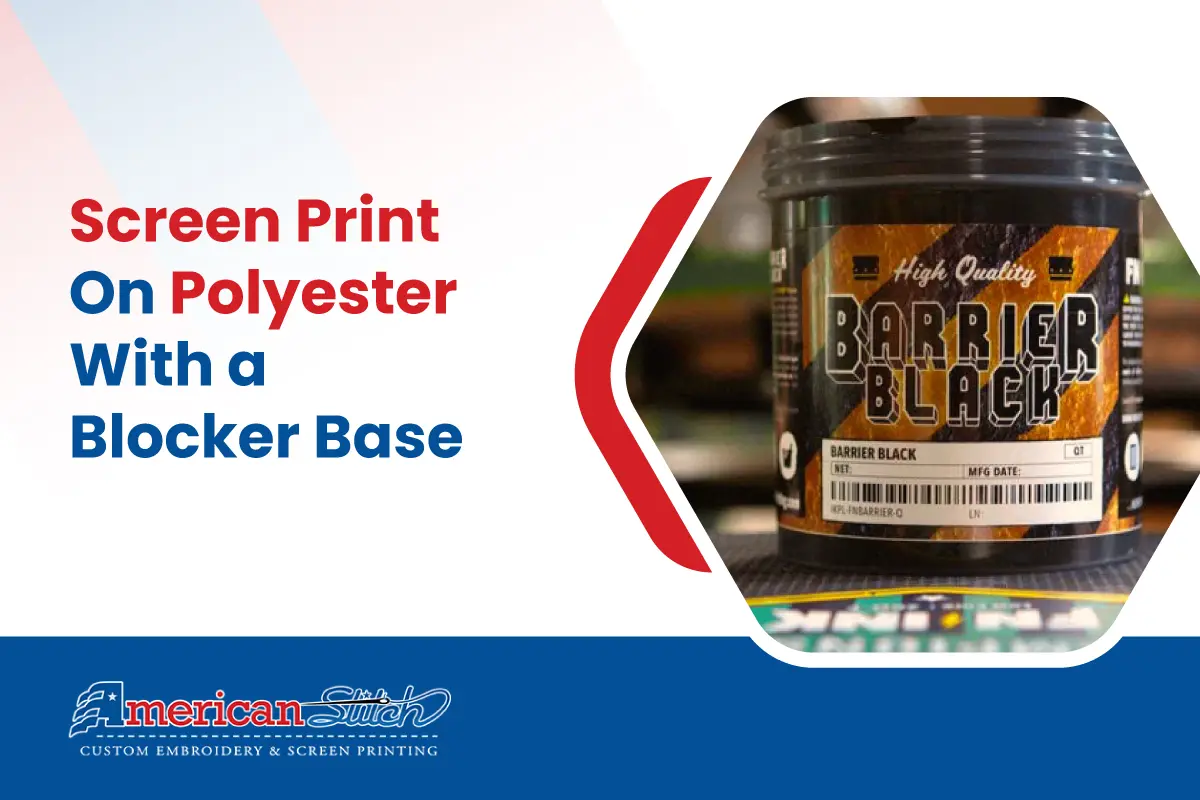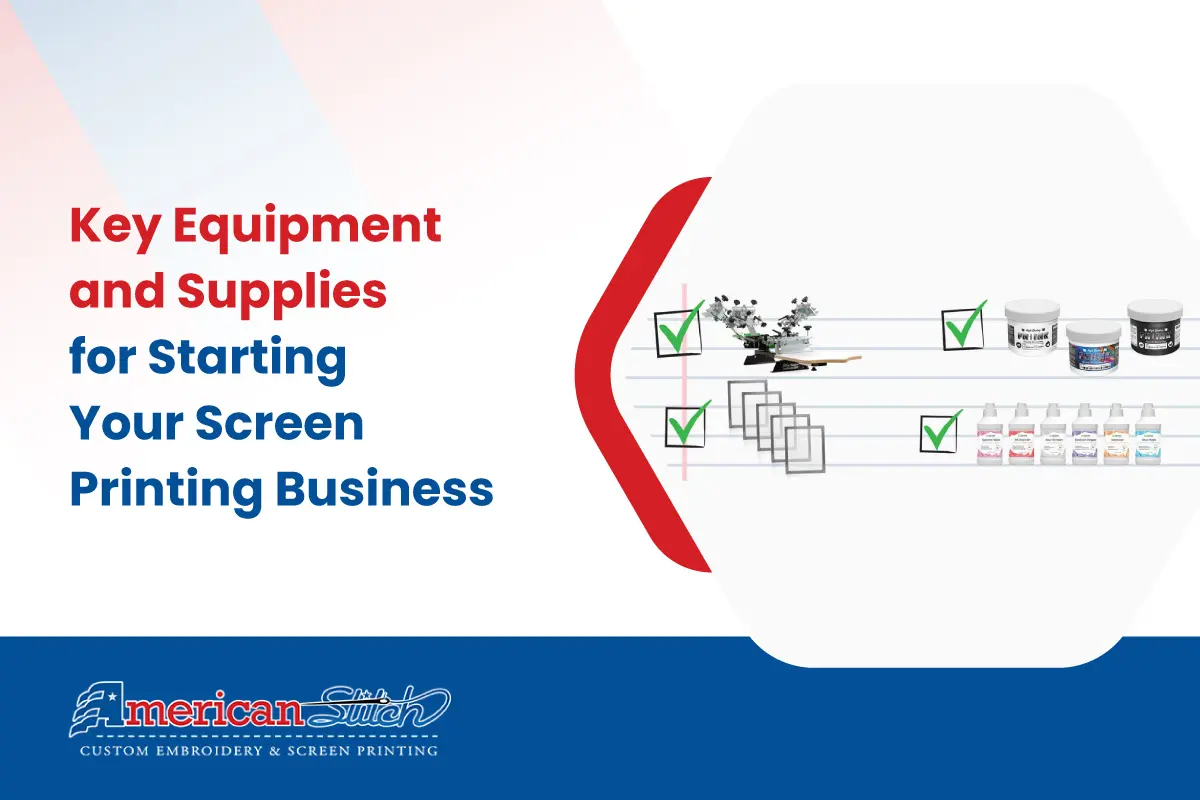Screen printing on polyester fabric offers a versatile and durable method for creating vibrant designs on clothing, accessories, and various textiles. Polyester is known for its resilience, colorfastness, and smooth texture, making it a popular choice for apparel manufacturing and promotional merchandise.
However, achieving successful prints on polyester can be challenging due to its low absorbency and tendency to repel water-based inks. To overcome these challenges, many screen printers turn to using a blocker base, a specialized coating applied to the printing screen.
In this guide, we’ll delve into the intricacies of screen printing on polyester with a blocker base, exploring its benefits and providing step-by-step instructions for achieving professional results.
Table of Contents
Overview of Screen Printing on Polyester
Screen printing, also known as silk screening, is a technique that involves transferring ink through a mesh screen onto a substrate, such as fabric, paper, or plastic. This process allows for the creation of intricate designs with vibrant colors and precise details. Polyester fabric, with its smooth surface and moisture-wicking properties, presents both opportunities and challenges for screen printers.
Using a Blocker Base in Screen Printing
A blocker base, also referred to as an under base or barrier coat, is a specially formulated emulsion or block-out solution applied to the printing screen before printing. Its primary function is to improve ink adhesion and prevent bleeding on challenging substrates like polyester. By providing a smooth and tacky surface, the blocker base enhances the ink’s ability to adhere to the fabric, resulting in sharper prints and minimized color migration.
Importance of Using a Blocker Base for Printing on Polyester
Polyester’s low absorbency and hydrophobic nature pose significant obstacles to achieving satisfactory print results. Without proper adhesion, the ink may sit on the fabric’s surface, leading to poor color saturation, smudging, and uneven prints.
Moreover, polyester’s inherent elasticity can cause prints to crack or peel over time without a reliable foundation. Using a blocker base addresses these concerns by creating a receptive surface for the ink to adhere to, ensuring long-lasting and vibrant prints on polyester fabric.
Additionally, the blocker base helps to mitigate issues such as ink bleeding and feathering, resulting in cleaner and more precise designs.
What Is Polyester Fabric?
Polyester fabric is a synthetic material known for its versatility, durability, and widespread use in the textile industry. Understanding the properties, challenges, and benefits of polyester fabric, screen printers can employ effective techniques and strategies to achieve high-quality prints that meet the demands of their clients and projects.
Properties of Polyester Fabric
Polyester is a man-made polymer derived from petroleum. Its molecular structure consists of long chains of repeating units, imparting several distinctive properties to the fabric:
- Durability: Polyester fabric is highly resistant to stretching, shrinking, and wrinkling, making it ideal for garments and products requiring long-term wear and tear.
- Moisture-wicking: Polyester has inherent moisture-wicking properties, allowing it to efficiently draw moisture away from the body, making it a popular choice for activewear and performance apparel.
- Colorfastness: Polyester fabric retains its color vibrancy even after repeated washes and exposure to sunlight, ensuring that printed designs remain vivid and intact over time.
- Low Absorbency: Unlike natural fibers such as cotton, polyester has low absorbency, meaning it does not readily absorb liquids. This characteristic presents challenges when printing with water-based inks, as the ink may sit on the fabric’s surface rather than being absorbed.
Challenges of Printing on Polyester
Despite its numerous advantages, printing on polyester presents several challenges for screen printers:
- Poor Ink Adhesion: Due to its low absorbency and smooth surface, polyester fabric often struggles to retain ink, resulting in poor adhesion and potential ink smudging or bleeding.
- Ink Curing Issues: Polyester’s high melting point requires specialized curing methods to ensure proper ink adherence and durability. Improper curing can lead to premature fading, cracking, or peeling of the printed design.
- Color Migration: Polyester’s moisture-wicking properties can cause printed colors to bleed or migrate, especially when exposed to moisture or heat during the curing process.
Benefits of Screen Printing on Polyester
Despite these challenges, screen printing on polyester offers several notable benefits:
- Vibrant colors: Screen printing allows for precise color control and layering, resulting in vibrant and eye-catching designs on polyester fabric.
- Long-lasting prints: When executed correctly with proper preparation and curing, screen prints on polyester can withstand repeated washes and wear without fading or deteriorating.
- Versatility: Polyester fabric is versatile and can be used for a wide range of applications, including apparel, accessories, promotional items, and signage. Screen printing offers endless possibilities for customization and personalization on polyester substrates.
What is a Blocker Base?
A blocker base plays a crucial role in achieving successful screen prints on polyester fabric by enhancing ink adhesion, reducing color migration, and improving overall print quality.
By choosing the appropriate blocker base and mastering its application techniques, screen printers can unlock endless possibilities for creating stunning and durable prints on challenging substrates.
Let’s delve into its definition, purpose, types, and advantages in the context of screen printing.
Definition and Purpose of Blocker Base
A blocker base, also known as an under base or barrier coat, is a specialized coating applied to the printing screen before the ink is transferred onto the substrate. Its primary purpose is to enhance ink adhesion and prevent ink from bleeding or smudging on challenging surfaces, particularly polyester fabric.
The blocker base creates a tacky surface on the screen, which helps the ink adhere more effectively to the substrate during the printing process. By providing a reliable foundation for the ink, the blocker base ensures sharper, more vibrant prints with minimal color migration or distortion.
Types of Blocker Bases Available
Several types of blocker bases are available to screen printers, each offering unique properties and applications:
Emulsion-based Blocker Base
Emulsion-based blocker bases consist of a photo-sensitive emulsion that is applied to the printing screen and cured using UV light. These blocker bases offer excellent adhesion and durability, making them suitable for high-volume production runs and intricate designs.
Block-out Solution
Block-out solutions are liquid coatings applied directly to the printing screen to block out areas where ink should not pass through. These solutions are typically used for spot-color printing or creating intricate designs with fine details.
Dual-cure Blocker Base
Dual-cure blocker bases combine the properties of emulsion-based and block-out solutions, offering both excellent adhesion and precise control over ink placement. These blocker bases are ideal for printing on challenging substrates like polyester, as they provide superior ink adhesion and minimize color bleeding.
Advantages of Using a Blocker Base in Screen Printing
The use of a blocker base in screen printing offers several distinct advantages:
- Improved Ink Adhesion: By creating a tacky surface on the printing screen, the blocker base enhances ink adhesion to the substrate, ensuring crisp and vibrant prints with minimal smudging or bleeding.
- Reduced Color Migration: Polyester fabric is prone to color migration, where printed colors spread or bleed into adjacent areas. The blocker base helps contain the ink within the desired boundaries, minimizing color migration and preserving the integrity of the printed design
- Enhanced Print Quality: With the proper application of a blocker base, screen printers can achieve sharper and more precise prints on polyester fabric, even when using water-based inks. The blocker base acts as a foundation for the ink, resulting in consistent and professional-quality prints.
Preparation Steps
Before embarking on the screen printing process on polyester with a blocker base, it’s essential to ensure that both the fabric and the printing equipment are properly prepared. This section outlines the crucial preparation steps involved in achieving optimal results.
By following these preparation steps diligently, screen printers can create a solid foundation for successful screen printing on polyester fabric with a blocker base. Properly prepared fabric and screens ensure optimal ink adhesion, print clarity, and overall print quality, setting the stage for a seamless printing process and stunning end results.
Preparing the Polyester Fabric
#1: Washing and Drying
Polyester fabric often comes with a finish or coating that can interfere with ink adhesion. To remove any residue and improve ink penetration, it’s crucial to pre-wash the fabric before printing. Follow these steps:
- Use a mild detergent and cold water to wash the fabric.
- Avoid using fabric softeners or bleach, as they can leave residues that affect ink adhesion.
- Rinse the fabric thoroughly to remove all traces of detergent.
- Hang or tumble dry the fabric on a low heat setting until completely dry.
#2: Pre-treating if Necessary
Depending on the specific characteristics of the polyester fabric, pre-treatment may be necessary to enhance ink adhesion and minimize bleeding. Consider the following pre-treatment options:
- Use a polyester-specific pre-treatment solution designed to improve ink adhesion on synthetic fabrics.
- Apply the pre-treatment solution according to the manufacturer’s instructions, ensuring even coverage over the entire printing area.
- Allow the pre-treated fabric to dry completely before proceeding with the printing process.
Preparing the Screen and Blocker Base
#1: Choosing the Right Mesh Count
The mesh count of the printing screen plays a crucial role in determining the level of detail and ink deposit in the final print. When printing on polyester fabric, opt for a higher mesh count to achieve finer details and smoother prints. Consider the following guidelines:
- Select a mesh count between 160 and 230 for most polyester printing applications.
- Higher mesh counts (230 or above) are suitable for intricate designs and fine details, while lower mesh counts (160-200) are better for bold and opaque prints.
#2: Applying the Blocker Base to the Screen
Proper application of the blocker base is essential for ensuring optimal ink adhesion and print quality. Follow these steps to apply the blocker base to the printing screen:
- Mix the blocker base according to the manufacturer’s instructions, ensuring proper consistency and viscosity.
- Apply a thin, even coat of the blocker base to both sides of the printing screen using a scoop coater or squeegee.
- Ensure that the blocker base covers the entire mesh area of the screen, paying special attention to the image area where the design will be printed.
- Allow the blocker base to dry completely before exposing the screen to light or applying ink.
Printing Process
Once the preparation steps are complete, it’s time to move on to the printing process. This section provides a comprehensive guide to each stage of printing on polyester fabric with a blocker base, from setting up the screen and fabric to applying the ink and employing techniques for optimal results.
Setting Up the Screen and Fabric
Position the Screen:
- Secure the printing screen in the desired location on the printing press or printing station.
- Ensure that the screen is properly aligned with the fabric and that the printing area is flat and level.
Register the Design:
- Use registration marks or alignment guides to ensure precise positioning of the design on the fabric.
- Adjust the screen and fabric as needed to achieve accurate registration.
Secure the Fabric:
- Place the pre-treated and pre-dried polyester fabric on the printing platen or substrate.
- Use adhesive or tape to secure the fabric in place and prevent shifting during the printing process.
Applying the Ink with the Blocker Base
Load the Ink:
- Prepare the desired ink colors for printing, ensuring they are properly mixed and free of any contaminants.
- Load the ink onto the screen using a scoop coater or squeegee, ensuring even coverage across the entire image area.
Flood the Screen:
- Use a flood stroke to fill the mesh openings of the screen with ink, ensuring uniform distribution and preventing ink from drying out.
Print the Design:
- Lower the screen onto the fabric, making sure it makes full contact with the surface.
- Apply firm and consistent pressure to the screen as you pull the squeegee across the mesh, transferring the ink onto the fabric.
- Lift the screen carefully to reveal the printed design, ensuring clean and crisp edges.
Printing Techniques for Polyester Fabric
Flood and Stroke Method:
- Use the flood and stroke method to ensure even ink coverage and prevent streaks or uneven prints.
- Flood the screen with ink before each print stroke to replenish the ink supply and maintain consistent color saturation.
Light Pressure:
- When printing on polyester fabric, apply light to moderate pressure to the screen to prevent the fabric from stretching or distorting.
- Avoid excessive pressure, which can cause the ink to bleed or smudge on the fabric.
Tips for Achieving Crisp Prints
Maintain Proper Ink Consistency:
- Regularly check the viscosity and consistency of the ink to ensure smooth and uniform printing.
- Thin the ink with a compatible reducer if necessary to achieve the desired flow and coverage.
Optimize Curing Conditions:
- Use a conveyor dryer or heat press to cure the printed designs at the recommended temperature and duration.
- Ensure that the curing conditions are optimized for polyester fabric to achieve maximum ink adherence and durability.
Conduct Test Prints:
- Before proceeding with full production runs, conduct test prints to evaluate ink adhesion, color accuracy, and overall print quality.
- Make adjustments as needed to optimize print settings and achieve the desired results.
Curing and Finishing
Proper curing and finishing are essential steps in the screen printing process, particularly when working with polyester fabric. This section explores the significance of curing prints, methods for curing polyester prints, and post-printing finishing techniques to ensure optimal durability and longevity of printed designs.
Importance of Curing the Prints
Curing the prints is crucial for achieving maximum ink adherence and durability. Proper curing ensures that the ink is fully cured and bonded to the fabric, preventing premature fading, cracking, or peeling of the printed designs. Without adequate curing, the prints may not withstand repeated washes or wear, compromising their quality and longevity.
2 Effective Methods for Curing Polyester Prints
#1: Curing With Conveyor Dryer:
- Conveyor dryers are commonly used in screen printing facilities to cure prints efficiently and consistently.
- Set the conveyor dryer to the recommended temperature and speed for curing polyester prints, typically between 320°F to 350°F (160°C to 177°C).
- Ensure that the printed fabric passes through the dryer for the recommended duration to achieve thorough curing.
#2: Curing With Heat Press:
- A heat press can also be used to cure polyester prints, especially for smaller production runs or individual items.
- Set the heat press to the recommended temperature and apply firm pressure to the printed fabric for the specified duration.
- Use a protective sheet or Teflon cover to prevent scorching or sticking of the printed design.
Post-Printing Finishing Techniques
After curing the prints, it’s essential to implement post-printing finishing techniques to ensure the best results:
Washing and Drying:
- After curing, allow the printed fabric to cool before washing to prevent damage to the printed design.
- Wash the printed fabric using a mild detergent and cold water, following the manufacturer’s instructions for care.
- Hang or tumble dry the fabric on a low heat setting until completely dry, avoiding high temperatures that could damage the print.
Additional Curing if Needed:
- In some cases, additional curing may be necessary to ensure maximum ink adherence and durability.
- If the prints show signs of insufficient curing or if additional wash resistance is required, consider subjecting the fabric to another round of curing using the preferred curing method.
Troubleshooting Common Issues
Even with careful preparation and execution, screen printers may encounter common issues during the printing process on polyester fabric with a blocker base. This section addresses prevalent problems related to ink adhesion and bleeding, providing practical solutions for achieving better results.
Issues with Ink Adhesion
Lack of Ink Adhesion:
- Problem: Ink may fail to adhere properly to the polyester fabric, resulting in poor print quality and adhesion issues.
- Solution:
- Ensure that the fabric is properly pre-treated and free from any contaminants or residues that could interfere with ink adhesion.
- Check the blocker base application to the screen; uneven or inadequate coating may hinder ink adhesion.
- Verify that the curing process is optimized for polyester prints, as insufficient curing can lead to poor ink adherence.
- Experiment with different ink formulations or additives designed to improve adhesion on synthetic fabrics.
Ink Peeling or Flaking:
- Problem: Printed designs may peel or flake off the fabric, especially after washing or wear.
- Solution:
- Increase the curing time and temperature to ensure thorough curing of the ink, promoting better adhesion and durability.
- Use a compatible bonding agent or adhesion promoter to enhance the ink’s bond with the fabric surface.
- Avoid overloading the fabric with excessive ink, as thick ink deposits can hinder adhesion and lead to peeling or flaking.
Problems with Ink Bleeding
Color Migration:
- Problem: Colors may bleed or migrate into adjacent areas, resulting in blurred or distorted prints.
- Solution:
- Use a blocker base with anti-bleed properties to contain the ink within the desired boundaries and prevent color migration.
- Opt for inks specifically formulated for printing on polyester fabric, as they are less prone to bleeding or spreading.
- Increase the mesh count of the printing screen to achieve finer details and sharper prints, reducing the risk of ink bleeding.
Wet-on-Wet Printing Issues:
- Problem: Wet-on-wet printing, where multiple colors are applied without allowing each layer to dry completely, can lead to ink bleeding or smudging.
- Solution:
- Allow sufficient drying time between each color layer to prevent the risk of ink bleeding or smudging.
- Use a flash cure unit or heat press to partially cure each color layer before applying subsequent colors, ensuring better ink adhesion and preventing color mixing.
Solutions for Achieving Better Results
Conduct Test Prints:
- Problem: Inconsistent print quality or adhesion issues may arise during production runs.
- Solution:
- Conduct test prints on sample fabric before starting full production runs to identify any potential issues and fine-tune printing parameters.
- Adjust ink formulations, curing conditions, and printing techniques based on the results of test prints to achieve optimal outcomes.
Troubleshoot Equipment:
- Problem: Equipment malfunctions or inconsistencies can affect print quality and adhesion.
- Solution:
- Regularly maintain and calibrate printing equipment to ensure consistent performance and reliable results.
- Monitor ink viscosity, screen tension, and curing temperatures to identify and address any equipment-related issues promptly.
Conclusion
Screen printing on polyester fabric with a blocker base offers a wealth of benefits, but it also presents unique challenges that require careful attention and expertise. As we conclude this guide, let’s recap the advantages of using a blocker base, offer final tips for successful polyester printing, and encourage experimentation and practice to achieve the best results.





